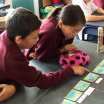Build language-rich environments
Create an environment that extends and supports language growth.
On this page:
On this page:
Current page section: Build language-rich environments
Go to top of current page: Build language-rich environments
Go to top of current page: Build language-rich environments
Go to top of current page: Build language-rich environments
Develop language-rich displays
Develop language-rich displays
Create displays that extend children’s language growth. Regularly refresh the displays in collaboration with ākonga and whānau.
Ideas for rich language environments:
- Display big ideas with visuals.
- Use zones to make it easy to find key supports. For example, chemistry and biology areas or inquiry zones.
- Use images, photos and displays to prompt language-rich conversations.
- Include photos of shared activities such as field trips to prompt ongoing discussions.
- Create vocabulary and word walls. Keep them uncluttered. Refresh them to reflect current topics.
- Use pouches, resource boxes, photos or QR codes so students can take resources to their desks or personal devices.
- Make spaces that are unique to Aotearoa, for example, spaces reflect te ao Māori and te reo Māori is prominent and integrated across all areas.
- Create displays that give ākonga access to key vocabulary, task steps, success criteria, thinking tools and models.
Use visual prompts
Use visual prompts
Tuluiga Aiiloilo-Maka from Wiri Central School talks about how she uses visual prompts to stimulate conversations and develop vocabulary. The visuals inspire writing and are the basis for oral presentations. (Starts at 1:23.)
Download the video transcript.
Source: Ministry of Education Te Tāhuhu o te Mātauranga
Closed Captions
Build subject-specific vocabulary
Build subject-specific vocabulary
Use techniques that help students to build their subject-specific vocabulary.
Techniques include:
- Help students to take an active role by creating their own vocabulary lists and visual dictionaries.
- Ask students to identify a personal vocabulary list from a reading.
- Link words with images, graphics, physical movements or signs to support recall.
- Create word walls in collaboration with students.
- Use graphic techniques that include colour and shape to support recall.
- Use games such as Pictionary, Articulate or Charades to reinforce meaning. In Articulate students must guess the word from a description.
- Reinforce new words by using them repeatedly and encouraging students to use them.
- Add current vocabulary to wall displays. Remove old displays. Old displays can be photographed or turned into a reference book.
Use narrative frameworks
Use narrative frameworks
Narrative frameworks, for example, those from te ao Māori, support culturally relevant and language-rich approaches. They can assist understanding and recall by providing reference points or metaphors for complex concepts and systems.
Next steps
More suggestions for implementing the strategy “Helpful classroom strategies years 9-13”:
-
Current page Build language-rich environments
Return to the guide “Speech, Language and Communication”

Speech, Language and Communication
How to use this site
Guide to Index of the guide: Speech, Language and Communication
Strategies for action:
-
Identify needs and how to provide supportShow suggestions for Identify needs and how to provide support
-
Key areas to supportShow suggestions for Key areas to support
-
Helpful classroom strategies years 1-8Show suggestions for Helpful classroom strategies years 1-8
-
Helpful classroom strategies years 9-13Show suggestions for Helpful classroom strategies years 9-13
